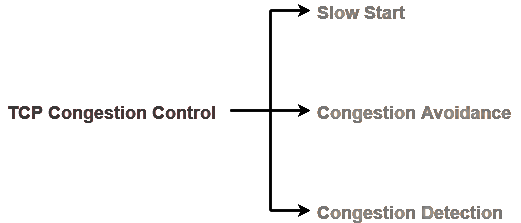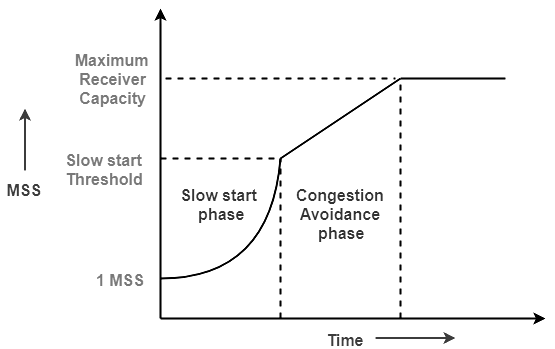TCP Congestion Control | Computer Networks - Computer Science Engineering (CSE) PDF Download
Congestion in Network
- Congestion is an important issue that can arise in Packet Switched Network.
- Congestion leads to the loss of packets in transit.
- So, it is necessary to control the congestion in network.
- It is not possible to completely avoid the congestion.
Congestion Control
Congestion control refers to techniques and mechanisms that can:
- Either prevent congestion before it happens
- Or remove congestion after it has happened
TCP Congestion Control
The size of the sender window is determined by the following two factors:
- Receiver window size
- Congestion window size
1. Receiver Window Size
- Sender should not send data greater than receiver window size.
- Otherwise, it leads to dropping the TCP segments which causes TCP Retransmission.
- So, sender should always send data less than or equal to receiver window size.
- Receiver dictates its window size to the sender through TCP Header.
2. Congestion Window
- Sender should not send data greater than congestion window size.
- Otherwise, it leads to dropping the TCP segments which causes TCP Retransmission.
- So, sender should always send data less than or equal to congestion window size.
- Different variants of TCP use different approaches to calculate the size of congestion window.
- Congestion window is known only to the sender and is not sent over the links.
So, always
Sender window size = Minimum (Receiver window size, Congestion window size)
TCP Congestion Policy
TCP’s general policy for handling congestion consists of following three phases-

- Slow Start
- Congestion Avoidance
- Congestion Detection
1. Slow Start Phase
- Initially, sender sets congestion window size = Maximum Segment Size (1 MSS).
- After receiving each acknowledgment, sender increases the congestion window size by 1 MSS.
- In this phase, the size of congestion window increases exponentially.
The followed formula is
Congestion window size = Congestion window size + Maximum segment size
This is shown below
- After 1 round trip time, congestion window size = (2)1 = 2 MSS
- After 2 round trip time, congestion window size = (2)2 = 4 MSS
- After 3 round trip time, congestion window size = (2)3 = 8 MSS and so on.
This phase continues until the congestion window size reaches the slow start threshold.
Threshold
= Maximum number of TCP segments that receiver window can accommodate / 2
= (Receiver window size / Maximum Segment Size) / 2
2. Congestion Avoidance Phase
After reaching the threshold,
- Sender increases the congestion window size linearly to avoid the congestion.
- On receiving each acknowledgement, sender increments the congestion window size by 1.
The followed formula is:
Congestion window size = Congestion window size + 1
This phase continues until the congestion window size becomes equal to the receiver window size.

3. Congestion Detection Phase
When sender detects the loss of segments, it reacts in different ways depending on how the loss is detected
Case-01: Detection On Time Out
- Time Out Timer expires before receiving the acknowledgement for a segment.
- This case suggests the stronger possibility of congestion in the network.
- There are chances that a segment has been dropped in the network.
Reaction
In this case, sender reacts by:
- Setting the slow start threshold to half of the current congestion window size.
- Decreasing the congestion window size to 1 MSS.
- Resuming the slow start phase.
Case-02: Detection On Receiving 3 Duplicate Acknowledgements
- Sender receives 3 duplicate acknowledgements for a segment.
- This case suggests the weaker possibility of congestion in the network.
- There are chances that a segment has been dropped but few segments sent later may have reached.
Reaction
In this case, sender reacts by:
- Setting the slow start threshold to half of the current congestion window size.
- Decreasing the congestion window size to slow start threshold.
- Resuming the congestion avoidance phase.
|
23 videos|171 docs|81 tests
|
FAQs on TCP Congestion Control - Computer Networks - Computer Science Engineering (CSE)
| 1. What is TCP congestion control? |  |
| 2. How does TCP congestion control work? |  |
| 3. What is Slow Start algorithm in TCP congestion control? |  |
| 4. How does TCP congestion control prevent packet loss? |  |
| 5. Can TCP congestion control be disabled or modified? |  |





















